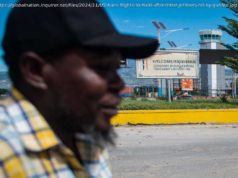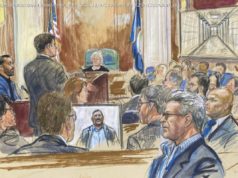Puerto Rican officials say only 62 people died from the storm. Researchers estimate more than 1,000 people did.
More than two months after Hurricane Maria slammed into Puerto Rico and devastated the island — knocking out its power grid and leaving millions without potable water — the official death toll has stayed surprisingly low at 62.
Yet no one who’s been following Puerto Rico’s hurricane disaster closely believes that to be an accurate representation of the lives taken by the storm. Journalists on the ground in Puerto Rico and here on the mainland have helped paint a very different picture of underreported deaths, prompting members of Congress to demand audits of the death count.
Now two social science researchers have shown that the actual death count may be closer to 1,085, a number that exceeds the government’s official figure by a factor of 18. (By comparison, at least 1,800 people died in connection to Hurricane Katrina in 2005 — the deadliest hurricane to hit US soil in the past 50 years.)
Alexis Santos, a Puerto Rican demographer at Penn State, and Jeffrey Howard, an independent health scientist and epidemiologist, calculated average monthly deaths from 2010 through 2016 using a methodology that other researchers have told Vox is one of the best ways to calculate estimates of disaster deaths.
Santos and Howard used the Puerto Rico Vital Statistics System to compare the historical averages for September and October of the past seven years to the total number of September and October 2017 deaths recently reported by the Puerto Rico Department of Public Safety to see if there were notable differences.
The results were staggering: They found that in September 2017 — the month that Maria hit — there were 518 more deaths than the recent historical average for September and 567 more deaths in October 2017 than the recent historical average for October. That’s a total of 1,085 deaths likely linked to the hurricane. And given that widespread power outages have continued into November, the number of indirect deaths from the hurricane is probably higher still.
The finding supports reports from several media outlets, including Vox, CNN, and BuzzFeed, that found hundreds of hurricane-related deaths that were not included in the official count. These reports were based on interviews with funeral home directors, doctors, and local officials. On November 21, a CNN investigation found 499 hurricane-related deaths reported by funeral homes from September 20 to October 19, for example.
The government of Puerto Rico has defended its methodology of counting storm deaths, repeating that its figure, last updated to 62 on December 2, is accurate. But rather than actively trying to find and investigate reports of deaths in the aftermath of the storm, it has been passive, counting only deaths where all the information was easily accessible. The government has also been overly cautious in linking deaths to the hurricane, despite the strong evidence indicating that the real number is more likely in the hundreds, if not thousands.
To be sure, the hurricane severely damaged not just Puerto Rico’s power infrastructure and health care system but also basic government functions and medical data collection. And the island’s death processing system has been totally overwhelmed.
Santos and Howard’s work is still in preprint form, which means it has not yet been through peer review. And the government still has not released its official death totals for September and October. So treat these findings as preliminary.
But they suggest that the official toll is far from accurate and does not convey the extent of the impact of the hurricane. (A New York Times analysis of the same data from Puerto Rico’s Vital Statistics System also found that in the 42 days after the storm hit, 1,052 more people than usual died across the island.)
“The issue of how many deaths there were from the devastation goes hand in hand with the attention this is going to get in Congress,” said Santos.
Puerto Rico Gov. Ricardo Rosselló recently asked that Congress and federal agencies give $94.4 billion in funds for recovery, on the grounds that it will be the “most transparent” recovery effort in US history.
But there isn’t much transparency around this statistic that is fundamental to understanding this disaster — the death toll shapes how we perceive the extent of the harm, how we assess the response, and how many resources we allocate for recovery. And Puerto Ricans, meanwhile, are being left in the dark, wondering if their loved ones lost after the storm will ever be acknowledged by their government.
The dispute between the government and the media over the Hurricane Maria death toll began when an investigative reporter on the island, Omaya Sosa Pascual, questioned the official death toll of 16 in a story on September 28, eight days after the storm hit. Sosa confirmed that there were dozens of hurricane-related deaths the government had not yet accounted for and that the true number was likely in the hundreds.
Yet the official number didn’t rise.
The number, still 16, then became politicized on October 3 when President Donald Trump visited the island and insisted that the alleged 16 deaths were evidence that Puerto Rico wasn’t a “real catastrophe” like Hurricane Katrina. «Everybody watching can really be very proud of what’s taken place in Puerto Rico,» he said.
Since then, the death count has slowly risen to 62. But several media outlets, including Vox and Sosa’s organization, the Center for Investigative Journalism (CPI), have collected ample evidence that the real number is much higher — and that the government continues to underreport it.
The government tried to put the issue to rest forever in a press conference on November 8 that was intended to provide reporters with more details about how it had calculated the official toll, by then 55.
«We want to explain this to you all so that all doubts about how we counted the deaths will finally end here,» Héctor Pesquera, head of the Department of Public Safety, said.
But instead of resolving doubts, officials presented new data suggesting that the true number is likely much higher (the same data that Santos and Howard used in their analysis). According to the government, there were a little under 3,000 deaths registered on the island in September 2017. That’s over 500 more deaths than were reported in September 2015 and 2016.
“The reality is that this is not normal and we have to realize that there was a phenomenon here,” said José A. López Rodríguez, a government demographer at the press conference. Yet he stopped short at attributing any of them to the storm. “There needs to be evidence to document it,” he said.
But in fact, there’s plenty of additional evidence to suggest that the number of people who died directly or indirectly from Hurricane Maria is in the hundreds, if not more than 1,000.
For an initial investigation published October 11, Vox searched Google News for reports of deaths in English and Spanish media from Puerto Rico since Hurricane Maria. We found reports of a total of 81 deaths linked directly or indirectly to the hurricane. Of those, 45 were the deaths certified by the government. The remaining 36 deaths were confirmed by local public officials or funeral directors, according to the reports. We also found another 450 reported deaths, most of causes still unknown, and reports of at least 69 people still missing.
The investigation prompted two members of the House of Representatives to request an audit of the Puerto Rico death toll from the Department of Homeland Security. Sens. Elizabeth Warren and Edward Markey then demanded the same.
Since then, additional sources and reports continue to point to the same conclusion: that hundreds, not dozens, of people died from the storm, despite claims by President Trump and Puerto Rican officials that the count is 62 or fewer.
FEMA has determined that 537 of those burial applications were not related to Hurricane Maria, including people who erroneously asked for funeral assistance while seeking other FEMA aid. There were an additional 168 pending cases where applicants had provided the required documentation, or were in the process of getting it to FEMA, as of November 6.






